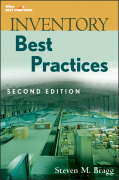
INDICE: Preface. Chapter 1 Success or Failure with Best Practices. Types ofBest Practices. Most Fertile Ground for Best Practices. Planning for Best Practices. Timing of Best Practices. Implementing Best Practices. How to Use BestPractices: Best Practice Duplication. Why Best Practices Fail. Summary. Chapter 2 Inventory Purchasing. 2.1 Include Suppliers in the New Product Design Process. 2.2 Use Supplier-Concurrent Engineering. 2.3 Avoid Designing Risky-Procurement Items into Products. 2.4 Match Product and Part Life Cycles. 2.5 ReduceSafety Stock by Shrinking Supplier Lead Times. 2.6 Purchase Supplier Capacity. 2.7 Reduce Safety Stocks by Accelerating the Flow of Internal Information. 2.8 Buy from Suppliers Located Close to the Company. 2.9 Relocate Suppliers On-Site. 2.10 Use Local Suppliers for Rapid Replenishment. 2.11 Consider Foreign Sourcing. 2.12 Use Auctions for Selective Purchases. 2.13 Compare Suppliers Based on Total Landed Cost. 2.14 Eliminate Approvals of Routine Purchases. 2.15 Purchase Based on Material Requirements Planning. 2.16 Compare Open Purchase Orders to Current Requirements. 2.17 Freeze the Short-Term Production Schedule.2.18 Share Production Plan with Suppliers. 2.19 Obtain Direct Links into Customer Inventory Planning Systems. 2.20 Require Frequent Deliveries of Small Quantities. 2.21 Arrange for Inbound Split Deliveries. 2.22 Arrange for Phased Deliveries. 2.23 Adopt Rolling Schedules. 2.24 Adopt Just-in-Time Purchasing. 2.25 Implement Stockless Purchasing. 2.26 Centralize Purchasing. 2.27 Designate Major Suppliers as Lead Suppliers. 2.28 Single-Source Products. 2.29 Install aSupplier Rating System. 2.30 Use Long-Term Supplier Relationships for Strategic Purchases. 2.31 Shift Raw Materials Ownership to Suppliers. 2.32 Flag Changes Impacting Advance Material Requests. Chapter 3 Inventory Receiving and Shipping. 3.1 Reject Unplanned Receipts. 3.2 Obtain Advance Shipping Notices for Inbound Deliveries. 3.3 Directly Enter Receipts into Computer. 3.4 Automatically Collect Inbound and Outbound Cube and Weight Information. 3.5 Repackage Incoming Items into Increments Ordered by Customers. 3.6 Put Away Items Immediately After Receipt. 3.7 Stage Received Goods for Zone Putaways. 3.8 Eliminate theReceiving Function. 3.9 Combine the Shipping and Receiving Functions in One Area. 3.10 Assign Docks Based on Minimum Warehouse Travel Time. 3.11 Require Supplier Deliveries with Open-Sided Trucks Directly to Production. 3.12 Ship Using Returnable Wheeled Containers. 3.13 Use Dunnage Bags to Cushion Outbound Shipments. 3.14 Use Shippers with the Most Consistent Delivery Performance. 3.15Have Delivery Person Deliver the Invoice. 3.16 Pay Suppliers Based Only on Receiving Approval. 3.17 Provide Pending Shipment Information to the CollectionsStaff. Chapter 4 Inventory Storage. 4.1 Drop Ship Inventory. 4.2 Cross-Dock
- ISBN: 978-1-1180-0074-8
- Editorial: John Wiley & Sons
- Encuadernacion: Cartoné
- Páginas: 304
- Fecha Publicación: 16/03/2011
- Nº Volúmenes: 1
- Idioma: Inglés
